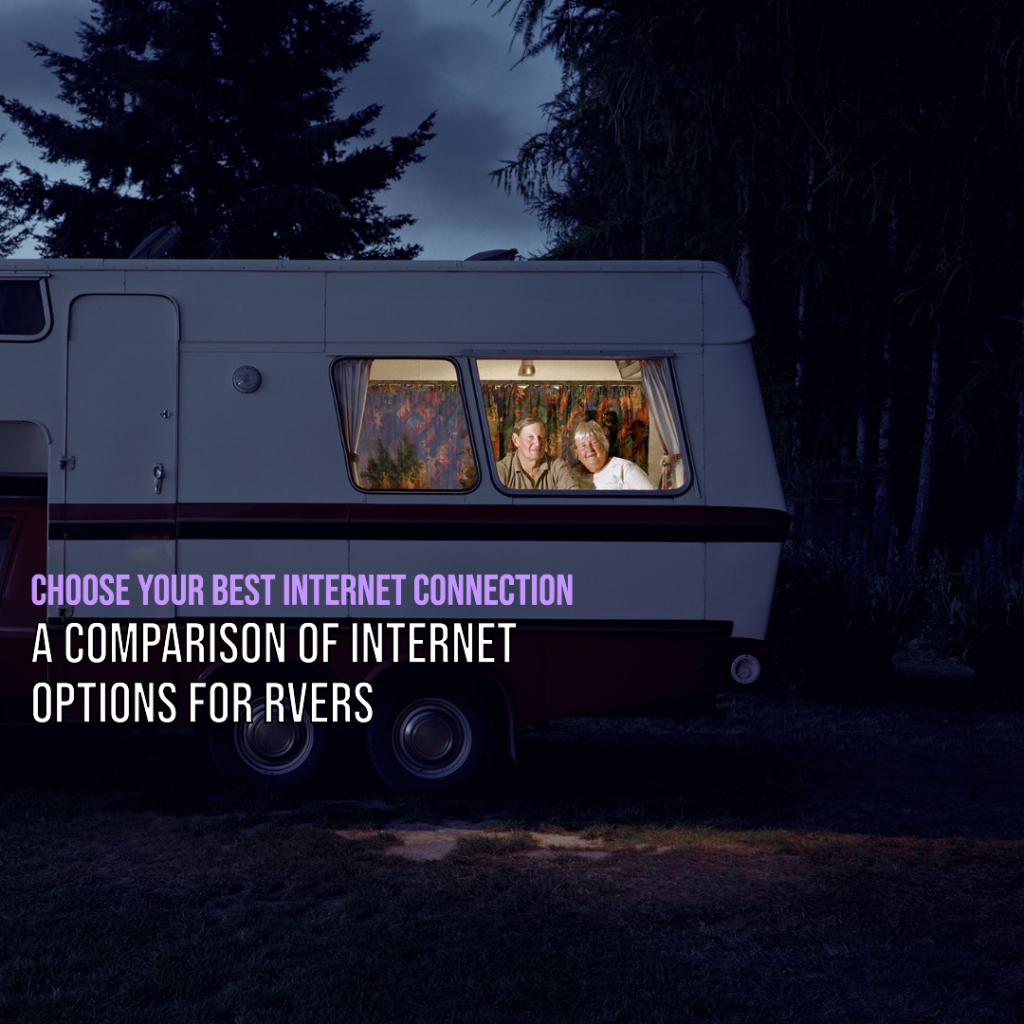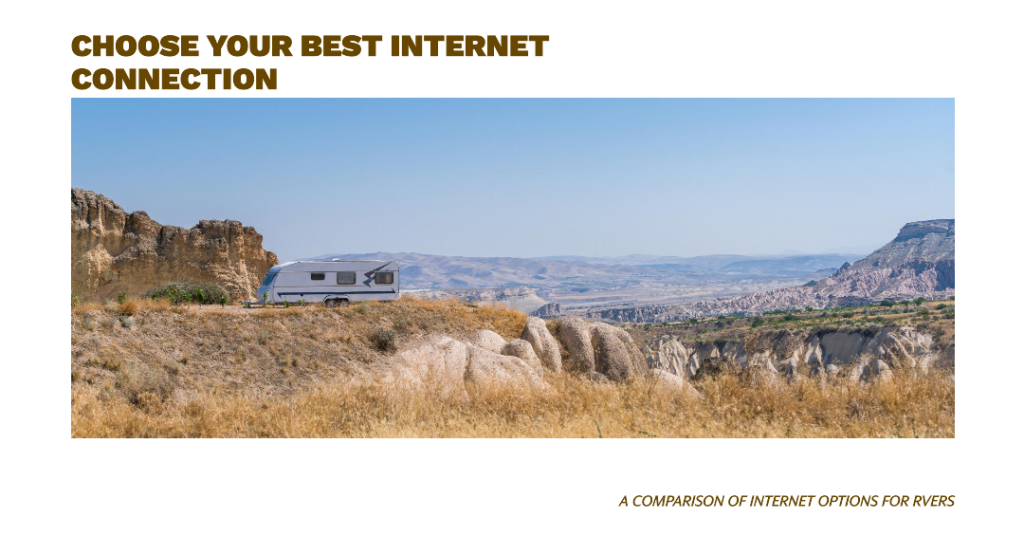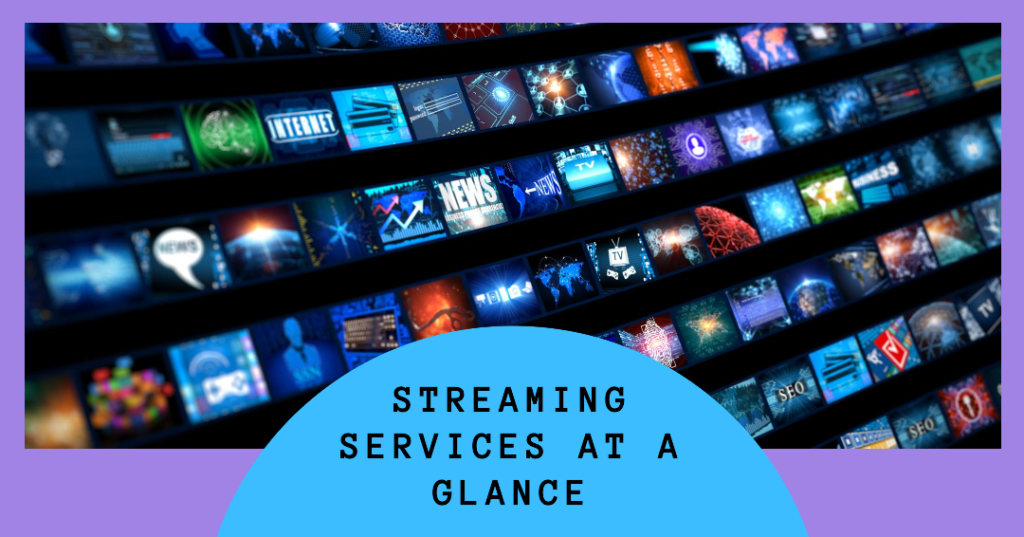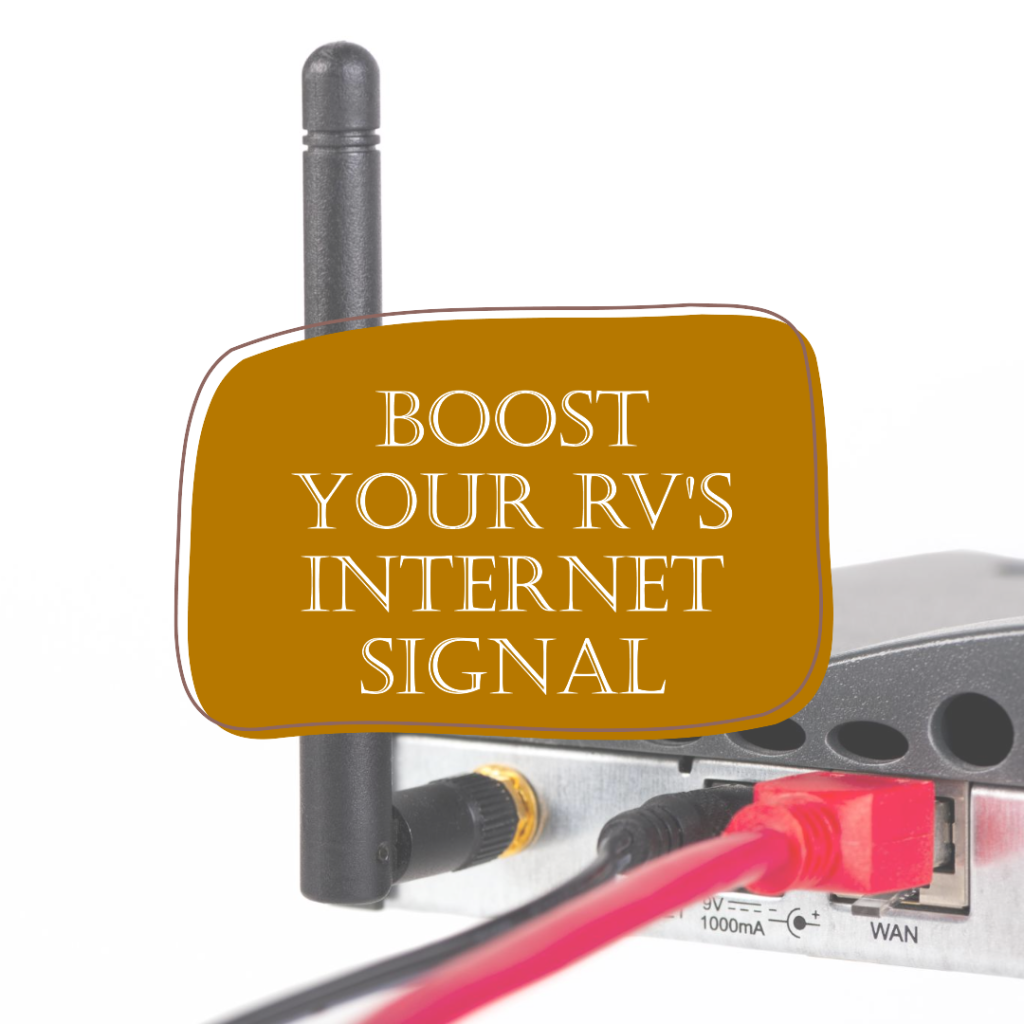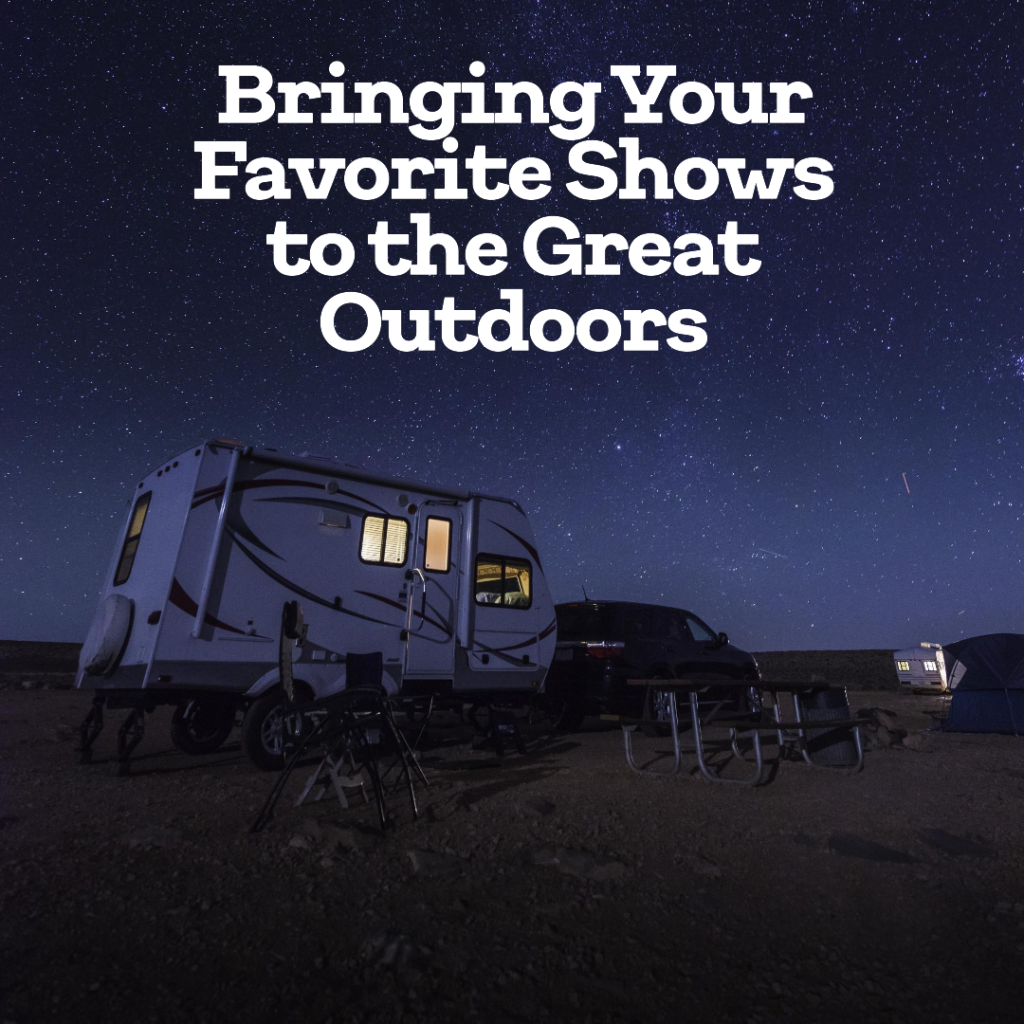Listen to our in-depth discussion about RV Streaming options. This audio explains key insights and actionable tips you won’t want to miss.
The Ultimate Guide to RV Streaming in 2025
Updated November 26, 2024
Streaming on the Road
Imagine relaxing at your campsite after a long day of exploring, only to discover there’s nothing good on local TV. For many RVers, this can be a frustrating scenario. But with the right setup, you can stream your favorite shows and movies just like you do at home, no matter where you are.
This guide not only covers the basics but also dives into real-world solutions and forum-proven tips to tackle common RV streaming challenges, including location restrictions and unreliable internet.
Here’s what you’ll find:
- The best internet options for streaming on the road, tailored to different travel styles.
- Devices designed for RV streaming, from smart TVs to portable hotspots.
- Top streaming services and their limitations, with practical workarounds.
- Power-saving tips to keep your entertainment rolling without draining your RV battery.
- Proven techniques to manage location-based restrictions, including VPNs and offline downloads.
RVing is about freedom, and your entertainment should match that spirit. Say goodbye to fuzzy campground cable and hello to seamless streaming, whether you’re nestled in the woods or parked near the beach.
Here’s What You’ll Learn in This Guide
This guide is your ultimate resource for enjoying seamless streaming while RVing. Here’s a breakdown of what you’ll discover:
- Explore the Different Internet Options for RV Streaming
Learn about cellular data plans, satellite internet options like Starlink RV, and campground WiFi setups, and how to choose the best connection for your travels. - Discover the Best Streaming Devices for RVers
From smart TVs and streaming consoles like Roku or Fire Stick, to versatile game consoles, you’ll find the right tools for entertainment. - Compare the Most Popular Streaming TV Services for RVers
Uncover the pros and cons of YouTube TV, Sling TV, Hulu + Live TV, Amazon Prime Video, and Netflix, with tips on navigating location restrictions. - Learn Practical Tips for Boosting Your RV’s Internet Signal
Maximize your connectivity with cellular boosters like WeBoost, portable WiFi hotspots, and strategies for staying connected in remote areas. - Find Out How to Download Shows and Movies for Offline Viewing
Enjoy uninterrupted entertainment in areas with no connectivity by downloading your favorite shows and movies in advance using services like Netflix and Amazon Prime Video.
Can You Ditch Cable and Stream Like a Pro?
RVing is all about embracing the freedom of the open road. But that doesn’t mean you have to sacrifice your favorite shows and movies. Gone are the days of fuzzy campground cable! With a strong internet connection and the right tools, you can stream your entertainment just like at home.
What makes this possible? Advances in mobile internet, satellite solutions, and streaming devices tailored for travelers mean you can enjoy high-quality entertainment almost anywhere. However, location-based restrictions and buffering can still pose challenges—challenges this guide will help you overcome.
Real-World Tips:
- Understanding Address Changes for Streaming Services: Services like YouTube TV limit the number of address changes per year, with restrictions requiring home-area logins every three months. On the other hand, Sling TV ties its service to your billing zip code. RVers recommend using VPNs or services with fewer location requirements, like Netflix or Amazon Prime Video, for easier streaming on the go.
- Forum Insight: Full-time RVers often share creative solutions, like assigning a trusted friend to log in from your home location when required or using devices with disabled location tracking (e.g., Apple TV or Shield devices).
This guide will help you identify and overcome these challenges so you can ditch cable entirely. Say goodbye to static-filled broadcasts and hello to seamless streaming, wherever your travels take you.
Devices to Stream On
Now that you’ve secured your internet connection, it’s time to pick your streaming setup. Here are the devices RVers commonly use to stream shows and movies on the road:
Built-in Entertainment Hubs: Smart TVs
Many modern RVs come equipped with smart TVs, which eliminate the need for additional streaming devices. Simply connect your RV to WiFi or cellular data, and you can access platforms like Netflix, Hulu, and Amazon Prime Video directly from the TV.
- Pros:
- All-in-one convenience.
- Built-in compatibility with most popular streaming apps.
- Cons:
- Requires consistent internet for live streaming.
- Limited app support on older or budget models.
Forum Tip: Ensure your smart TV’s firmware is updated regularly to maintain compatibility with streaming apps. RVers often recommend brands like Samsung and LG for their robust app ecosystems and reliable performance on the road.
Plug-and-Play Powerhouses: Streaming Consoles
For RVers without a smart TV, streaming consoles like Roku and Amazon Fire TV Stick are easy-to-use alternatives. These compact devices connect to your RV’s TV via HDMI and support a wide range of streaming services.
- Pros:
- Affordable and portable.
- Simple setup with intuitive interfaces.
- Cons:
- Some apps (e.g., Hulu Live) may require location services, which can complicate access when frequently moving.
Real-World Insights: Roku devices are highly rated by RVers on forums for their flexibility with location changes, making them a preferred choice over the Fire TV Stick in some cases.
Double Duty Dynamos: Game Consoles
Did you know your Xbox or PlayStation can double as a streaming device? Game consoles support apps like Netflix, Hulu, and Amazon Prime Video alongside your favorite games.
- Pros:
- Multi-functional for gaming and streaming.
- High-quality performance and storage capacity for downloads.
- Cons:
- Bulky and less portable than other options.
- Higher power consumption, which may be a concern for boondockers.
Forum Tip: If you have a robust RV power setup and enjoy gaming, consoles can be an excellent dual-purpose device for entertainment.
Mobile Marvels: Phones, Tablets, and Computers
Sometimes, the simplest solutions are the best. Your phone, tablet, or laptop can double as a streaming device with the right apps installed.
- Pros:
- Extremely portable and versatile.
- Offline downloads available on many streaming platforms.
- Cons:
- Smaller screen sizes may not be ideal for group viewing.
- Heavier data usage on mobile networks when streaming live.
Pro Tip: Consider using a portable dock to connect your tablet or laptop to a larger monitor or TV screen in your RV. Apps like Netflix and Amazon Prime Video support offline downloads, making them great for areas with limited connectivity.
Forum Insight: Portable Screen Solutions
Many RVers tether their phones to a laptop or use a tablet as a second screen, offering flexibility without requiring extra equipment. Some also recommend using projectors for outdoor movie nights under the stars.
Top Streaming Services for RVing
With countless streaming platforms available, choosing the right service for your RV adventures can feel overwhelming. Here’s a breakdown of popular options, their standout features, and how they cater to the RV lifestyle:
Cord Cutters on the Go: YouTube TV & Sling TV
These services are ideal for RVers looking to replace traditional cable while maintaining access to live channels.
- YouTube TV:
- Highlights: Extensive channel lineup and unlimited DVR storage.
- Limitations: Allows only two home address changes per year and requires login from your “home area” every three months, which may be restrictive for full-time RVers.
- Sling TV:
- Highlights: Customizable packages for budget-conscious users.
- Limitations: Location services tie to your billing zip code, so you may lose access to local channels if traveling extensively.
Forum Insight:
RVers on forums suggest using a VPN to bypass location restrictions or opting for devices with flexible IP settings. For frequent movers, YouTube TV’s DVR capabilities are a big plus, while Sling’s affordability appeals to part-time RVers.
All-in-One Entertainment: Hulu + Live TV & Amazon Prime Video
These platforms combine live TV with a rich library of on-demand content, making them versatile choices for RVers.
- Hulu + Live TV:
- Highlights: Extensive live TV channels and a vast on-demand library.
- Limitations: The app may require enabling location services on mobile devices, which can be challenging for frequent travelers.
- Amazon Prime Video:
- Highlights: Robust library of movies, TV shows, and Amazon Originals. Membership perks like free two-day shipping make it a great value.
- Limitations: Does not include live local channels, so it’s better suited for on-demand content.
Forum Insight:
Amazon Prime Video’s offline download feature receives high praise from RVers who venture into remote areas without consistent internet access. Hulu Live’s combination of live TV and on-demand streaming makes it a great all-in-one solution, provided location requirements are managed.
Unbeatable Selection & Originals: Netflix
Netflix remains a staple for many RVers due to its vast library of movies, TV shows, and award-winning originals.
- Highlights:
- Exceptional on-demand content, including binge-worthy series and exclusive films.
- Offline download capability for uninterrupted viewing in areas without connectivity.
- Limitations:
- No live TV channels.
- Requires internet access for new downloads or app updates.
Forum Tip:
For boondockers or remote adventurers, pre-downloading Netflix content in high quality ensures an optimal viewing experience, even off the grid.
Choosing the Right Services
Your ideal streaming service depends on your needs:
- Want live channels? YouTube TV or Hulu + Live TV may be your best bets.
- Looking for affordability? Sling TV offers flexibility at a lower price.
- Need offline options? Netflix and Amazon Prime Video are perfect for remote viewing.
For full-time RVers, combining two or more services often provides the most comprehensive entertainment solution.
Connection Challenges: Keep Your Streams Flowing
Buffering can quickly turn a relaxing evening into a frustrating ordeal. Here are some tried-and-true strategies to overcome common streaming challenges and maintain a seamless entertainment experience on the road.
Boost Your Signal Strength
Struggling with weak WiFi or cellular signals at campgrounds or in remote locations? Invest in tools that enhance your connectivity:
- WiFi Range Extenders: Amplify weak campground WiFi signals to improve stability.
- Cellular Signal Boosters: Devices like the WeBoost Drive X RV or King Extend Pro strengthen weak cellular signals, helping you stream with fewer interruptions.
Forum Insight: RVers often recommend pairing boosters with coverage maps from carriers like Verizon or AT&T to identify areas with the strongest signals for travel planning.
Portable Hotspot Power
Portable WiFi hotspots, offered by carriers like Verizon, AT&T, and T-Mobile, provide a mobile internet solution for RVers. These devices create private hotspots, allowing you to connect multiple devices while traveling.
- Advantages:
- Flexibility to switch between providers for better regional coverage.
- Reliable streaming even in areas with limited public WiFi.
Pro Tip: Keep a backup SIM card from an alternative carrier to avoid coverage gaps. RV forums highlight the importance of redundancy, especially for full-time travelers.
Download and Conquer
Offline viewing is a game-changer for RVers heading to areas with unreliable or no connectivity:
- Services like Netflix, Amazon Prime Video, and Hulu offer offline download options, letting you preload content before your trip.
- Download shows and movies in high quality to enhance your viewing experience.
Forum Tip: RVers recommend prioritizing downloads during strong internet connections and double-checking storage space to avoid last-minute interruptions.
Optimizing Your Setup
For an uninterrupted streaming experience:
- Combine a cellular booster with a portable hotspot to maximize connectivity.
- Download must-watch content in advance for offline access.
- Position your RV to maximize line-of-sight for satellite connections or WiFi signals.
By integrating these tools and techniques into your travel routine, you can say goodbye to buffering and hello to smooth streaming, no matter where the road takes you.


